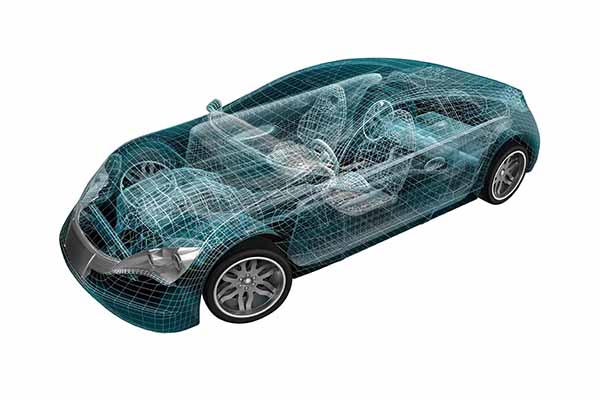The switch to a 48V electrical system is also reflected in the requirements for fuses and circuit breakers. Due to the higher voltage of 48V, mechanical relays are only suitable to a limited extent. The higher voltage means that the arc breaks later when the relay is opened. As a result, the service life of the relay is limited. Moreover the created arc can cause a disturbance in the on-board electrical system. Therefore, mechanical relays in current vehicle models are increasingly being replaced with resettable fuse elements based on power semiconductors. The Electronic Fuse or E-Fuse is an innovative solution to protect the electrical vehicles battery from electrical overload. By using an electronic fuse, the mechanical relay with its technical disadvantages can be successfully replaced.
Vishay offers a reference design of an E-Fuse for use in the 48V electrical system. This not only demonstrates the technical feasibility of such an application, but also demonstrates the performance of the company’s own power semiconductors. By using the latest technologies and developments, a 200A fuse in a compact design could be realized on a 125mm x 60mm FR4 PCB (Figure 1). The design is able to work as a bidirectional fuse as the MOSFETs are connected back-to-back. The maximum current is measured by means of a current measuring resistor from the Power Metal Strip series. These low ohmic resistors are specially suited for precise current measurements in automotive applications. The current for switching off is manually adjustable from about 1-200A with a potentiometer or controllable by controller. When the maximum allowed current is exceeded, the circuit is interrupted by the MOSFETs within about 1 μs. This rapid response is important to protect the vehicle’s battery from overload. The aim of the reference design is to show a modular structure with discrete semiconductors. Due to the modular design with several MOSFETs in parallel connection, the fuse can also be adapted to other power classes or requirements. Vishay’s wide range of resistors can also be adapted to the appropriate power class.
By connecting several power MOSFETs in parallel, a high current carrying capacity of up to 200A with low power dissipation is achieved (Figure 2) and the design can also be easily adapted to changing requirements. The reference design uses the latest generation of Vishay semiconductors. With the MOSFETs low “ON” resistance and the parallel connection, a very low power dissipation of around 14W is achieved with a current flow of 200A. In continuous operation with the maximum current of 200A, a heating of the MOSFETs and the board of around 75°C was measured. As a result, the electronic fuse does not require additional cooling, even in demanding use in automobiles. This can only be achieved in design through the use of electrically and thermally optimal components. The PowerPAK 8x8L proves to be the right choice here. Due to the thermally optimized design, a very good heat dissipation of the MOSFETs is achieved. In addition, the housing is suitable for applications with high requirements, as the solder joints are robust against thermal expansion due to the gullwing-like bending of the leads. To optimize the design or for higher currents, the MOSFETs used are also available in a backside cooled version. This allows the heat sink to be contacted directly with the solder joint of the drain contact. The direct connection of the semiconductor to the cooling system reduces the thermal resistance between the silicon chip and the cooling system. This allows the current carrying capacity of the MOSFET to be increased, allowing for greater design performance. The Power MOSFETs’ temperature is measured by a SMD NTC temperature sensor to monitor the stress on the semiconductors.

Measuring resistors of the Power Metal Strip series are primarily suitable for the precise measurement of currents. This technology is very stable over the entire working area against disturbances caused by environmental influences, such as temperature or voltage changes. This distinguishes current measurement by means of measuring resistors from other measuring methods that have limitations in the measuring or temperature range. Power Metal Strip series probe resistors are available from Vishay in a variety of power and ohm values. This allows the design to be adapted to other performance requirements.
Thin-film resistance arrays are used in the amplifier circuit to measure the current precisely. These components take advantage of discrete thin-film resistances and the fact that only one component is used here. The two resistors of the array are precisely matched to each other during production. This results in an almost identical behavior of the component in the event of possible disturbances, the ratio of the resistors thus remains identical and the measurement accuracy can be significantly improved.
It has been shown that the replacement of mechanical relays by an electronic fuse with semiconductors is possible and even advantageous. The solution can reduce interference to the on-board electrical system and other devices in the vehicle. In addition, semiconductors are not limited in the number of switching cycles, which allows for permanent application as a fuse or circuit breaker. Due to the modular structure of the E-Fuse, the design can be easily adapted and refined to changing requirements.
The design is freely accessible and can be found among other designs under https://www.vishay.com/landingpage/reference-designs.
About the author:
Stefan Volkmann is a senior field applications engineer for Vishay Europe Sales GmbH, located in Selb, Germany. He received his Dipl.-Ing at the University of Technology Dresden. Stefan has worked as a field applications engineer in Germany for different industrial segments, and started focusing on the automotive market in 2018. He is responsible for applications engineering and business development for major automotive accounts in Germany.
















